Altitude
In Peru everyone calls me the ‘Alto Mujer’, the tall woman. I sort of stand out in crowd around here, which is probably why I was picked to be robbed. But Alto, as in ‘Altiplano’, or the high flat plains between the mountains, are one of the reasons why I wanted to come here and so I headed from Arequipa to the Canon del Colca, the second deepest canyon the world by a bare 150 meters (and twice as deep as the Grand Canyon).
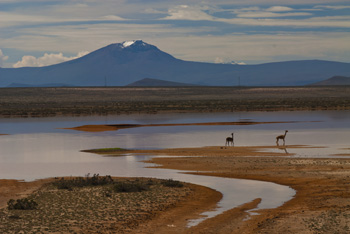
To get there you must go to the high places where the windswept mountainsides are constantly repainted by clouds and as far as the eye can see are rocks and more rocks and stunted clumps of ichu grass that are the primary fodder for camalids like domesticated llama, and alpaca, and the dainty vicuna that lives wild in a huge natural reserve created for them. Picture windswept plains and tiny flowers and the mighty volcanic peaks of El Misti (5822 m), Picchu Picchu (5571 m) and Chachani (6075 m) looming above everything. The air is clear and smells only of dust and grass and sometimes animal manure, and aside from the wind, there is only silence until a truck or tour bus passes.
I was fortunate. I paid for a car and driver for two days and Edgard was the perfect person. He spoke no English and I speak very little Spanish, but we got along sharing my Spanish/English Dictionary and he told me things about the places we went. The road went up and up through this staggering landscape until we reached the viewpoint of the volcanoes which stands at 4,900 Meters. Yes, meters.
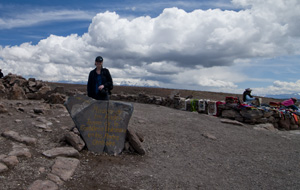
On all sides are these huge peaks and in the foreground small traveler’s cairns too numerous to be counted that give praise for having made it that far and to pray for good luck with the rest of their voyage. This was so similar to practices in India and Tibetan, China, that it made me realize how right the Inca were when they thought the huge mountains were inhabited by Apus, or gods.
From there we headed down towards the canyon and the small town of Chivay that sits at its head. Unfortunately I was struggling a bit with the altitude as we were still at 3,630 meters. It is a small town, but the capital of its District, and everywhere you went there were signs about the upcoming elections that occur April 10. The main square (Plaza des Armas) has a lovely fountain and tree-shaded benches and I spent a few hours relaxing in this slower paced life and watching he women in their traditional clothing.
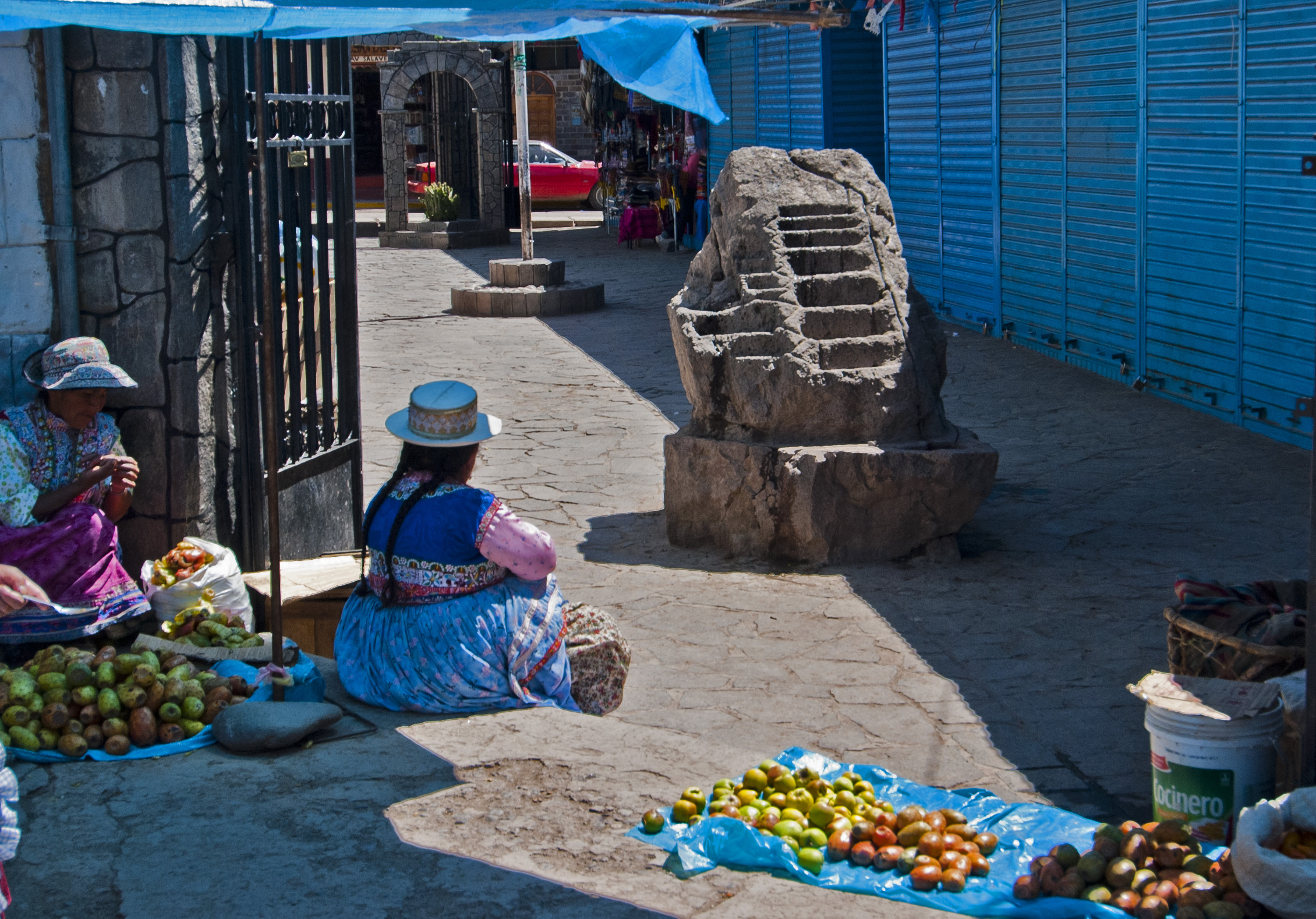
Edgard and I drove out the next day to see the valley. Actually, I almost called the whole thing off because I was feeling so ill, whether from Altitude sickness or the flu, I wasn’t sure. But at the last minute I thought I’ve come so far to see these birds and this valley, so I had to go.
So we went, through a valley that was filled with incredible Inca terracing up the mountainsides, each with their own microclimate so while one might be perfect for potatoes, others are perfect for Maize, or Quinua. We saw ancient tombs from pre-Inca times, and Inca-age rocks carved to keep track of the terracing. And then there was Cruz Del Condor.
Like entering a passport hall at a major airport, there was every language being spoken around you from the crowd that had made it this far to see. We were all perched in this high point of the cliff wall, waiting for the word the Condor had taken off and was rising up the cliff wall. I was there for one hour and saw one bird, but breathtaking isn’t the word. The swoop and soar on the wind. Everyone drew a breath so all you could hear was the swoop of huge wings and the frantic clicking of camera power-winds. And then he was gone. Magnificent and ephemeral as he swept away upwards and over the cliffs behind.
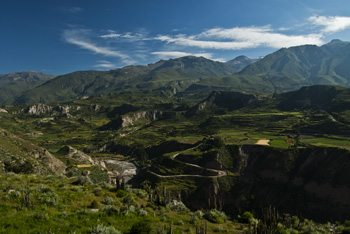
So Edgard left me with best wishes for my journey and went back to his lovely family in Arequipa. Apparently, his wife is an obstetrician and his children are studying medicine and engineering. Yesterday I climbed aboard a bus to Puno and drove 6 hours through the high altiplano again, but this time southeastward toward Lake Titicaca, that sits at 3,830 meters above sea level.
The countryside seemed filled with curves of hillsides that cloud shadows made seem to fold in on each other. A few lakes filled deep valleys, but mostly they are shallow affairs that overwinter flamingos. We arrived in Puno at 7:30 pm, coming down out of hills to see great arcs of darkness surrounded by lights. The darkness? Lake Titicaca.
So today I am in Puno, but unfortunately I’ve not seen much other than what I saw last night. You see, there is a price to be paid for being Alto in the altiplano world. The people here are built short and barrel-chested for a reason. Me, I’m about the antithesis of that physiognomy, and given I’d been sick from the moment I left Arequipa, I finally called a doctor. It seems the altitude has given me high blood pressure.
Which has made this Alto Mujer, a little more Plano at this moment.
But it was so worth it.
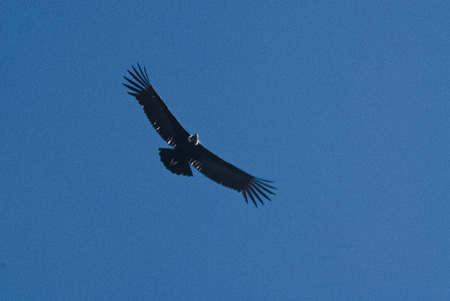
Arequipa, the good, the bad, and the sublime
I’ve been in Arequipa for three days after an arduous 16 hour bus ride down the coast of Peru and into the high desert that surrounds Arequipa. It is known as the white city of the Andes because it is back-dropped by three magnificent volcanoes and because in previous centuries its buildings were all made of sillar, which is white volcanic stone. Even the desert around here is of white sand.
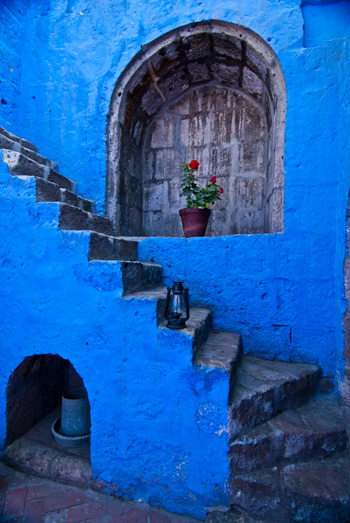
But regardless of the scenery, it’s the people of Arequipa – the Arequipenos – that I have fallen in love with. The love affair began with a call to an Arequipa guest house when I was in Lima. The owner didn’t have a spot for me, but she booked my stay at the Los Andes Hostel and also politely offered English classes. I’ve had three days of crash course 3 hours a day. I’m still not fluent, but I can fumble my way through an ‘Ola’ at least.
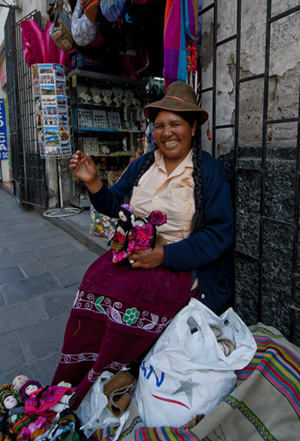
I’ve met lovely Indian women on the cobbled streets and murdered some Spanish to share bits of our lives. I’ve had a tour guide wait for me after a sublime tour through the Monastereo de Santa Catalina after dark, to gift me with a book about the place because we got to talking and her daughter has been gone for two months to my city of Vancouver and mom is worried. I offered to get in touch with her daughter when I get home. There have been so many more. The people smiling on the street, the man in the hostel who solved the mystery of why my newly minted Peruvian cell phone wouldn’t call Canada, the fantastic English teacher (how can you not love a man called Fabrizio), and he super nice hotel staff. And then here was the police man – but I’ll get to him.
The old part of Arequipa is built around a lovely square that is continually flocked with both pigeons and people. I mean this is the most use I have ever seen out of a park. During daylight hours every bench is filled and so is every inch of grass. The Pigeons own the pavement. Families chase after small children and the huge cathedral towers over it all. On the other three side of the Plaza are lovely arched galleries that shade from the sun of the rain that apparently comes heavily in January/February.
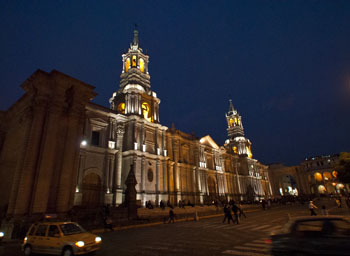
You see signs of the rains at the Monastery and at other old buildings as well. Water damage to precious old murals painted on the rock walls. Of course this is relatively minor compared to the damage earthquakes have caused. Both of the fine old monasteries I visited have undergone extensive restoration to deal with it.
The Monastereo de Santa Catalina is painted terra cotta and yellow and Mediterranean blue. It is filled with far too many niches and corners that caught my camera’s eye. I spent three hours there on my own one morning, just wandering through the silences. This monastery is still in use, though the number of nuns has significantly decreased from its heyday. These nuns were from wealthy families and had to pay handsome annual dowries to the monastery. They had their own apartments (the size and opulence dependent on their family’s wealth) as well as servants (read, slaves) and held dances and musical interludes. Not very nunnish, if you ask me.
Anyway, that all changed in the restoration and they shifted to more austere living arrangements, but still the place is filled with flowers and Moorish arches and hidden alcoves and fountains and goldfish and remaining nun have their part of the Monastery away from the world.
So I know you are all wondering about the policeman.
This morning, I went to the Museo de Arte Virreinal de Santa Teresa, a museum set in another monastery, that also has its nuns still in residence though they are depleted from 250 to 21 (apparently a specifically chosen number). Again I had a wonderful time and bought a lovely pumpkin-filled pastry to eat on my way home. So I’m happily walking down the street with camera bag and purse secured at my side and his man walks past. No problem. Suddenly he turns and rushes at me and slams into my side, while grabbing for the purse, but to take it, he basically has to take me, too, because it’s slung across my body. So he grabs my Buddha necklace that I never take off, and he rips it off my neck and takes off himself.
A man yells and runs after him. The people on the block are all yelling. They guide me to the police and so I end up with the tourist police and my policeman. Thankfully he spoke English.
So I gave my report and I won’t bore you with all the details, but will only say that I have had more apologies on behalf of Arequipenos, than you can shake a stick at. But the policeman was very kind. He took my information and the last time I saw him to pick up the formal statement for insurance purposes, he asked me (shyly) you are a writer? Yes.
Like books? Yes, I say.
What kind of books? I tell him.
Could I find your books on the internet? Yes.
Could I read them there? Again, yes. So I had to tell him about each one.
Which just goes to show that good can come from bad. Yes, I was robbed, but I gained an audience.
(I’m sending him a complimentary copy of one of my books.)

Security and Travel –It’s not just the dangers of the road
Sorting through the last few things I need to do for Peru, I’ve realized the numbers of actions I take to ensure security of myself and my belongings during travel and I thought they might be of value to others.
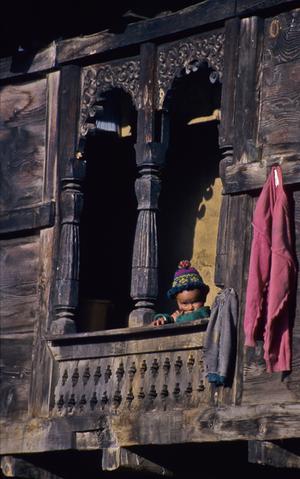
Thinking about security begins at home, because bad things can happen there while you are gone. Thieves work here as well as they do in a foreign country and if there is any chance they can learn you will be away (and there usually is) then you need to ensure your home is protected. Sure, you can cancel the newspaper and put in timers for lights, but the very fact you cancel your paper, or put a hold on our mail means that you’re sending a message into the universe that you’re not home.
In my situation, I took care of part of the concerns by having someone live in, but that isn’t always possible. My parents have had to deal with this a number of times when they have gone on extended trips. Often home owner’s insurance doesn’t cover you for extended absences. You need someone either in the home or checking the home frequently. This is especially the case in the cold weather months when a winter storm could mean a power loss and frozen pipes and flooding. Not what you want to come home to, especially if insurance won’t cover you because you haven’t had a house sitter while away.
The other consideration, especially when you have someone coming into your home, is to make sure your valuables are safe. For example, though I trust my cat sitter with their wellbeing, I know of others who have had house sitters and have found changes at home like computers reconfigured, and items missing. Worst of all are the creepy stories of someone rifling through your underwear and other private stuff.
To deal with this there are a few things I do. First, I always ask trusted neighbors to keep an eye on the place. Second, I remove everything of significant value like jewelry and either leave it with trusted friends, or place it in a safety deposit box. Along with the jewelry go my external hard drives for both my business and my writing computers in the hopes that even if the ‘Big One’ happens something will survive. Beyond my house and home, I also ask a neighbor to check my car and to start it a couple of times for me while I’m away. In the best of all worlds they would also take the car for a drive because it’s hard on the tires to be in stationary for a month. Last of all, I only give the house-sitter the minimum necessary keys and make sure I get them back immediately when I get home.
Okay. Home is safe. I hope. And the cats will be taken care of because I have left a long list of instructions and also have other people checking in on them.
That leaves me in another country, or in transit. With a backpack I used to always padlock the pack closed, but since 911 this doesn’t work. You are likely to find the lock cut off your pack and you in a foreign country with no solid lock. As a result I don’t lock the pack for the flight, but I do place it inside another bag, thus making it more trouble to break into. What I have is a large lightweight bag that can be broken down easily and stuffed into the bottom of my pack. This bag protects my bag from casual pilferage during flights into dodgy airports and also protects the backpack straps from getting caught in conveyor belt machinery.
When I’m traveling on foreign ground, I have a padlock for the pack’s top opening and also a bicycle chain so that the pack can be chained to something in my hotel room or to my bunk or seat on a train. I also carry electrician’s tape in case someone knifes the pack. The tape can fix just about anything.
For myself, I usually carry most of my traveler’s checks and cash in a money belt or pouch. Depending on the trip I might take both so that not everything is in one place. I also often wear a cross-shoulder purse which could be a target for thieves, but I wear a mesh photographer’s vest over the purse strap, so it isn’t exposed to knives. Finally, perhaps the best protection of all is confidence. Read your maps ahead of time and look confident and like you know where you are going when you are on the street. When you climb in a taxi on a dark night in a new city, make sure you have a map out and visible to the driver and act like you know where you are going, even if you don’t. This makes the driver less likely to drive you around to bump up the cost, or to drive you to places you don’t want to go. If you are arriving late at night, like I am, often you can arrange for the guest house or hostel to even pick you up at the airport.

So there I am. I’m not pretty, but I’m as secure as I can be and I’m as ready to travel as I’m going to get.
I’ll be in touch next from Lima.
Saying Goodbye – guilt and cats and manuscripts
There is nothing worse than having to walk out the door with two little feline faces gazing up at you with that “you’re not going to leeeeeaaaave us, are you?” look on their faces. Worse than kids, I think, because kids you can explain it to. Cats, however, they don’t get it and regardless of what anyone says, I know they pine when I’m not there.

No, this isn’t me anthropomorphizing my animals. My regular cat sitter has spotted the signs numerous times. I’m their pride leader – the alpha female—and when I’m gone, they go off their food. They start tearing things up when they never would before. Or they come rushing to the door and throw themselves at my cat sitter’s feet for pats, they are so starved for human attention.
Knowing this has made it very hard to travel without them. These cats actually travel very well and I swear they like to show off on their leashes for new people. When I’m forced to leave them at home for a business trip there’s always a guilty part of me that worries that I’m a bad pet owner. And of course I miss them and their warmth on my lap, Shiva acting like a mountain lion and peering down at me from atop the cupboards, and Ben chasing his tail every morning (he has yet to catch it). All the little rituals of catdom.
I’ve realized as I’m getting ready for this trip, that saying goodbye to my cats is a lot like saying goodbye to a manuscript. (Except, thank goodness, a manuscript doesn’t pine – does it?) For this length of time away I considered a variety of cat spas for the boys and I have to say there are some very nice ones, but it doesn’t matter the quality of the care, any cat spa is not their home and they won’t have the space to run that these two little bad boys need. As a result I managed to find a live-in house sitter. Making the choice to go this route is a lot like making decisions about whether to send a manuscript out to the world, or to self-publish.
With the traditional publishing route you need to assess your work for what kind of publisher might publish it. Consider what genre it is, but also consider whether it transcends a genre. For example, there are best sellers out there that are Science Fiction, but you won’t see them shelved in a science fiction section of a book store, because they are ‘bigger ‘ than a science fiction novel. An example is Jurassic Park. Harry Potter went far beyond Fantasy and the Thornbirds (gag) went beyond romance to family saga. For my cats, I knew they were ‘bigger’ than most cats –maybe not in size, but definitely in attitude and activity level.
You need to assess your manuscript to decide what publishers to send your work to, just as I had to assess whether a cat boarding situation might serve Ben and Shiva. Then you need to research your publishers to know whether they publish your kind of work. You need to identify an editor you think might be your target audience. A helpful place for this is Publisher’s lunch, or by listening to editor presentations, or reading their blogs. Then, or course, you need to edit and package your manuscript and get it out the door. I often find that this work – the business side of writing—is the toughest part of the whole ride, and I have to specifically schedule time to do it, or it won’t get done.
Self publishing is more like what I’ve done to arrange a home stay for my cats. It all falls to you to determine your product – cover, blurbs, and how the manuscript looks – just as I had to arrange exactly what I could live with for the boys. For the cats, this involved interviews and the cat sitter spending time with the boys.
For self-publishing, this takes patience and willingness to learn a whole new skill set and when you have the manuscript ready to go, it involves a whole new level of anxiety because although you’ve presumably done due diligence to make sure you’re your manuscript is decent and clean of mistakes, you are putting the work out there without having an editor tell you it’s perfect.
So you put it out there and the first time someone comes back to you to tell you it’s not perfect, you cringe. Just like a cringe when I learn the boys were lonely when I was gone. But in both cases I did what was right. I had to go, whether for business or to refill my soul with travel, and the manuscript –whether self published or published in the traditional sense—had to go too, because we’re writers, right?
And what we write is meant to be read.
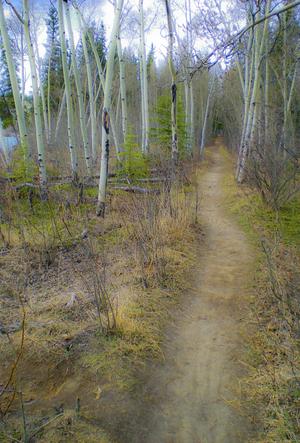
Biting the Bullet – or the ‘Oh *@#%’ moment
The other day, in the midst of planning my trip to Peru I had that old familiar rush of anxiety that I’ve had when planning for every other trip I’ve ever taken. It’s what I call the ‘oh shit’ moment.
I first came across this feeling when I was in my late twenties. I’d foolishly decided to relive my teen-age years by climbing onto a set of water skis. There I was at the end of a whiplashing line skimming along the water so fast I thought I was flying. Then the ‘oh shit’ moment arrived and all I could think of was ‘what the heck am I doing???????’ and ‘this is going to hurt like heck if I go down’.
And I did. Hard.
But I walked away with most of my pride. I’d tried it at least.
So planning a trip, or a book for that matter, can be a lot like the anticipation I had waiting to go up on those skis. I want to do it. I need to do it. But darn it, it can be scary.
I knew I was going to be whipping at the end of that line, just like I know I’m going to be stepping off of a plane into some place I’ve never been before. Some place I don’t speak the language or know the culture. Some place I don’t know if I’ll have the courage to get through.
Now that’s deep water. For a lot of people, that’s when they stop.
But that, to me, is part of what travel is all about. I don’t live in the age of exploration and I don’t have the physical prowess to climb mountains—so I do this. Run off to experience other places and the ways that people live. So the ‘oh shit’ moment is something to push through to prove myself.
In that way, each time I start a new book I find there’s an ‘oh shit’ moment. That’s when you open the computer to that blank page and say “okay, hands, start typing”. Like with the travel, I don’t really know where I’m going, the culture, or the characters I’ll meet, or if I’m prepared for the geography. Sure, I have plans, but we all know about plans.
I used to plot out everything just like I’d plan a trip, but what I found was it took the spontaneity out of the whole experience. I’ve actually found that I get frustrated when I plan a trip in too much detail, or when someone plans it for me. Having an itinerary means I can’t stay that extra day or take the time to step off of the beaten path or listen to locals about the road less travelled. The same can be said of a manuscript. Sure, having an outline can give you direction, but does it allow your characters to have adventures you never even imagined?
Travelling alone without any itinerary other than I know I want to go to this list of places (and sometimes I have to choose between them) means that yes, there are frustrations and yes, things might not always go as planned, but you also get some enormous gifts. Like meeting the young woman at Burma’s Schwedagon Pagoda who told me her tragic tale of love gone wrong, or stopping at the side of the road in Cambodia to meet shadow-puppet-making orphans whose story was so sad I ended up crying, or having dinner on the roof of a Rajasthani house with a family I met on the streets of a small Moghul fortress town. I learned so much from those encounters. Things I never would have had if I’d stuck to an itinerary.
And the same thing happens with writing. Yes, there’s the panicked feeling of not knowing where a story is going, and the fear that comes when I think things like ‘Dear god, I have to be coming to a mid-point climax, but I’m not sure what it is’. But I live with the fear and then, suddenly, by magic the driving direction or the climax appears. And it’s usually better than I ever could have imagined.
So when I feel that ‘oh shit’ moment when planning a trip, or starting a manuscript, or even when I’m caught in the middle, I remind myself that the ‘oh shit’ moment is more like the feeling the race horse must get in the gate: anticipation at the race. And wonder at what might be around the first turn.
The whiplash at the end of the line, or the gift of feeling like you’re flying.
And even if you fall, you had fun while you were trying.










